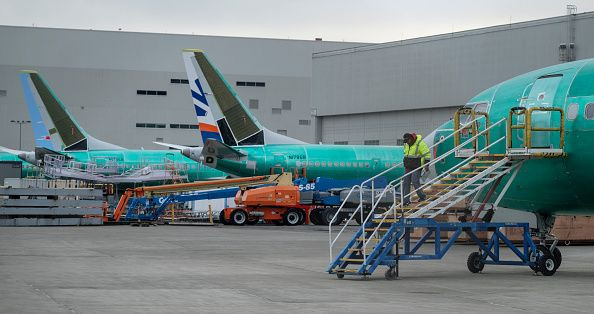Boeing Will Weather Storm, US Aircraft Output To Recover From 2020

The U.S. aircraft industry will take a hit from the Boeing 737 MAX groundings and the subsequent production cuts at the company, causing the aircraft gross output to drop more than 5 percent in 2019, Stephen Foreman, senior economist at Oxford Economics said, adding that the industry will gradually recover in 2020 and 2021.
The Boeing production cuts -- announced earlier this month -- will see production drop to 42 aircraft per month from 52 and are likely to last at least six months, he said. Foreman said the planemaker’s dominance in the aerospace market will help it weather the storm.
The U.S. aircraft, helicopter, drones, gliders sub-sector accounts for around half the headline U.S. aerospace products and parts output. The U.S. emerged as the biggest market for aerospace parts manufacturing in 2017.
Foreman said the overall impact on the headline U.S. aerospace products and parts, and the commercial aerospace supply chain will be comparatively limited.
“We forecast an output contraction of just 0.4 percent in the headline U.S. aerospace products and parts industry in 2019, with the fall in U.S. aircraft output being partly offset by limited aircraft parts production disruption and buoyant aerospace defense activity,” he wrote.
Boeing 737 MAX was the company’s hottest selling model before regulators across the world grounded them following two crashes -- that of a Lion Air plane in October off the coast of Indonesia, and an Ethiopian Airlines plane in March outside Addis Ababa -- which killed a total of 346 people.
Investigations into the two crashes have pointed to an error in a new anti-stall software in the jets, known as the Maneuvering Characteristics Augmentation System or MCAS. The final reports on the crashes are not yet out but Boeing now is in a race against time to update the MCAS software and get regulatory approvals for it so the planes can fly again.
While the Boeing cuts will act as a drag, limited parts disruption and buoyant missile and space growth will provide some relief for the industry, Foreman said.
“We expect output growth in the guided missiles and space vehicles to remain robust over the next few years, driven by increased military spending by the Trump administration. The strength in 2019 reflects a surge in U.S. defense shipments so far this year, which have risen by 8 percent year-on-year in the first two months of 2019,” Foreman told International Business Times.
He expects the annual inflation-adjusted gross output for guided missiles and space vehicles to rise to 7.7 percent in 2019, before cooling to 3.6 percent in 2020 and 3.2 percent in 2021.
Foreman expects no visible effect on the U.S. GDP growth from the Boeing production cuts and does not foresee more than a 0.2 percentage point hit to the total manufacturing growth in 2019.
He expects the U.S. aerospace parts and products industry to rebound in 2020 and 2021, with output growth of 3.5 percent and 3.1 percent, respectively, as these temporary cuts unwind. “While some order cancellations may occur, strong demand for single-aisle aircraft, and limited alternative aircraft should shield this U.S. aerospace giant from a mass cancellation of orders,” Foreman said.
Strong passenger demand, especially with the approaching peak-summer season, and a lack of alternatives for single-aisle aircrafts could see a temporary increase in the airline load factor, he said.
The alternatives to the Boeing 737’s single-aisle jet are limited and can barely keep up with half of the market’s current demand, he said. The Airbus A320neo -- the closest alternative single-aisle aircraft -- has an order backlog of nearly 6,000 aircraft, which could take several years to be delivered.
“And while Airbus plans to increase the production of these single-aisle aircraft, this will be difficult given ongoing supply-chain constraints,” Foreman said.
The impact across the commercial aircraft supply-chain will be much smaller given longer lead times, Foreman said.
“Some of Boeing’s aircraft parts suppliers -- such as Spirit AeroSystems -- do not plan to reduce production. Longer lead times relative to Boeing make temporary production cut very difficult, though they may be forced to as rising inventories start to hurt their profit margins,” he said.
The temporary cuts could, however, benefit some suppliers who have struggled with ramping up production in the recent years, such as aircraft engine manufacturers, he added.
The impact of the production disruption on sectors such as metals and machinery -- that supply materials and components to the aerospace sector -- will be moderate, given low exposure to aircraft demand.
“For instance, while aluminum is a key metal in the manufacturing of an aircraft, U.S. aerospace accounts for just 1 percent of total U.S. aluminum purchases. The aluminum sector sells its output to many other manufacturers across the industry -- such as automotive, beverages and boilers -- limiting its overall vulnerability,” Foreman explained.
He said the electronics sector -- including the watch, clock, and other measuring and controlling device manufacturing -- is more vulnerable to production disruption. “But some electronics sectors may be provided with relief as Boeing works to fix the control system that caused the crash,” he said.
© Copyright IBTimes 2024. All rights reserved.





















